How to write OKRs: A guide for effective Objectives and Key Results [+ Examples]
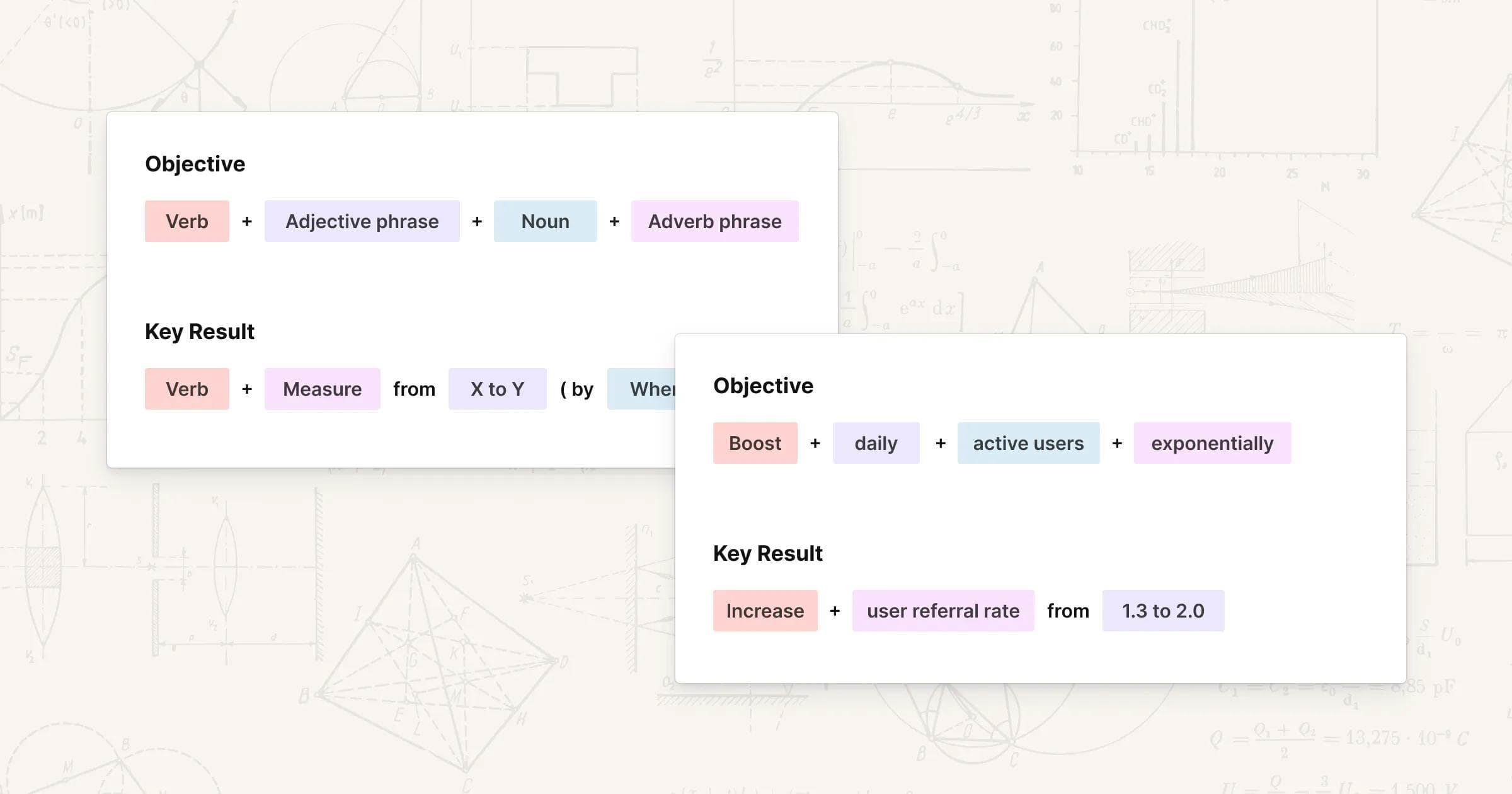
OKRs are becoming increasingly popular for strategic goal setting in organizations. The method itself is easy to understand, but the devil hides in the details: many organizations have failed because they simply did not write meaningful and good OKRs.
To make sure this doesn't happen to you, in this article we reveal the most important tips and tricks on how to write OKRs – including formulas that can be easily applied to every Objective and Key Result.
What you can expect:
- Why are well-written OKRs important?
- Preparation: Setting Objectives correctly
- Step-by-step guide to writing OKRs: Tips and formulas
- Don't do it like this! The 3 most common mistakes and negative examples
- Conclusion: This is how well formulated OKRs look like
- How to write OKRs – FAQ
Why are well-written OKRs important?
Whether companies are successful with OKRs (short for “Objectives and Key Results”) depends on a number of factors. The absolute basic requirement that anyone working with OKRs should master is writing good OKRs.
Why?
Because how well the company OKRs are written will determine whether the OKRs work and are actually achieved in the long run.
Poorly written individual OKRs (e.g., too general or unclear) usually do not provide companies with enough focus and clarity of content to achieve real success. In addition, everyone in the company can only work toward the common goals and track progress if the set OKRs are easy to read, understandable and self-explanatory. So some linguistic sensitivity is required here.
Preparation: How to write Objectives
Before formulating concrete Objectives and Key Results, it is important to talk about what you want to achieve and where the company is heading.
The first step should therefore be to have everyone sit down at the same table, gather ideas, set priorities, and select the right company Objectives. Only then can the linguistic nuances be worked out.
In most cases, the first step is to brainstorm possible Objectives, from which the most important Key Results are then derived. In order to filter out the right Objectives from the abundance of ideas, it is helpful to know what types of Objectives there are. A distinction can be made between:
- Build
- Improve
- Renew
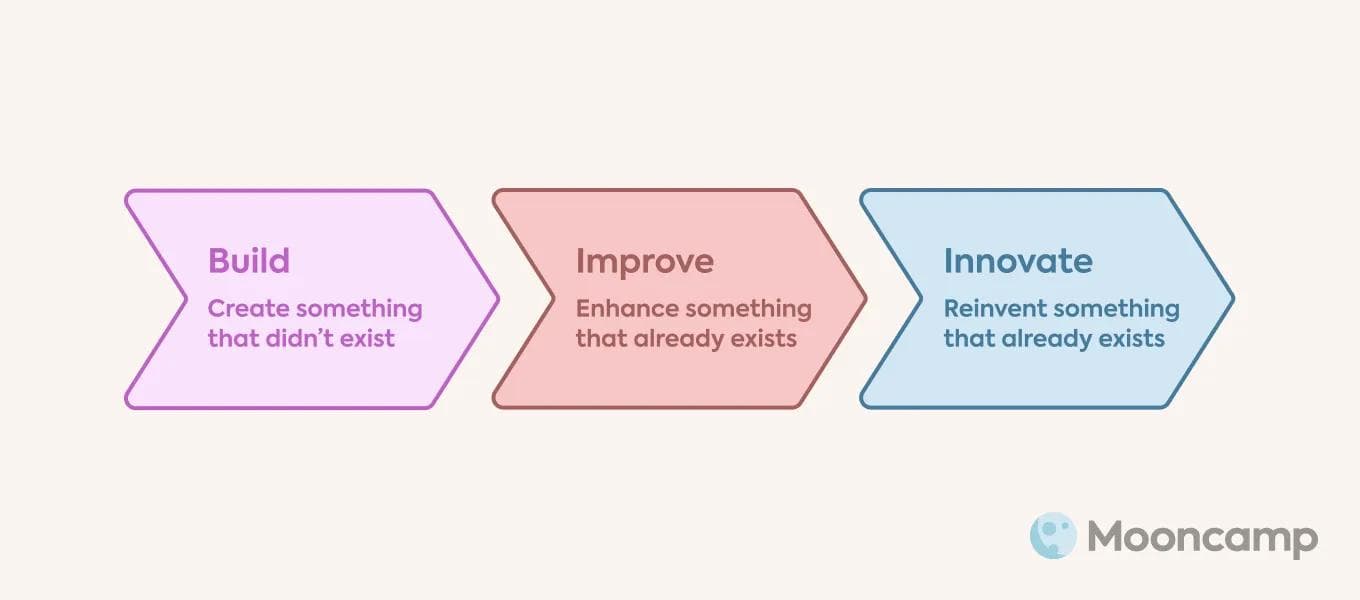
In this regard, for example, you can't improve anything that hasn't been developed yet. Therefore, the three types of Objectives are normally used in the order mentioned during the goal setting process.
The following tips will additionally help to create the right conditions for effective Objectives:
- Create context: Objectives should move a company forward directly or indirectly, always with the overarching vision and mission in mind. Accordingly, it should always be checked whether the Objectives really fit the corporate strategy. Moreover, the timing has to be right. Otherwise, an Objective loses its persuasive power.
- Involve teams: OKRs are only effective if they are embraced by every team member. Employees are often much closer to the action than management. Many teams therefore know from their day-to-day work what currently urgently needs to be built, improved or innovated and can make a valuable contribution to a great Objective if given the chance.
💡 Tip: Among other things, our Miro OKR planning template also contains a “Will do/won't do” exercise that helps with identifying the right OKRs.
Step-by-step guide to writing OKRs
Are you ready to write great OKRs?
Once it has been determined which Objectives you want to focus on for the next cycle, these basically “only” need to be formulated. However, this can be quite a challenge.
The good news is: There are some tips and formulas that will help you keep a cool head and not get bogged down with language. Basically, this rule applies to OKRs:
We will [Objective], as measured by [Key Results].
Objectives always answer the question “What do I want to achieve?”. Key Results focus on the question “How do I know that the Objective is reached?”.
Objectives should therefore be formulated in a qualitative, easy-to-understand and inspiring way.
Key Results, on the other hand, should be clearly measurable, results-oriented, and SMART.
We will go into more detail on each of these criteria and show you step by step how to write effective OKRs. In general you should keep in mind that not too many Objectives and Key Results should be defined per cycle. The focus should be on the most important things.
Two to four Objectives per team and cycle and one to five Key Results per Objective are enough. Sometimes it even makes sense to only set one or two Objectives per team.
Writing good Objectives
The first building block of aspirational OKRs is the Objective. In theory, this statement is relatively simple: An Objective should express what you want to achieve. But there is more to a good Objective.
Checklist for good (and specific) Objectives
There are some criteria for writing Objectives, which can be divided into “must-haves” and “nice-to-haves”.
The must-have characteristics that an Objective has to fulfill in order to qualify as an Objective are:
- Qualitative: An Objective should not contain measurable values.
- Directional: Objectives should set the direction in which a company wants to move in order to drive the business forward.
- Clearly aligned: To ensure that you are moving in the right direction, an Objective should be clearly aligned – for example, to the business strategy, corporate-level OKRs (for team Objectives), or key KPIs.
- Impactful: Objectives should be written in such a way that it makes a real difference to the business when the Objectives are achieved.
💡 Tip: Objectives can be a bit crazy. After all, they are meant to be remembered by the employees.
In addition, the following “soft” factors (nice-to-haves) can be considered in the formulation:
- Inspiring: Objectives should be formulated in such an inspiring way that all employees are spurred on by them.
- Comprehensible: Each individual Objective should be stated simply and briefly enough for all employees to understand and remember.
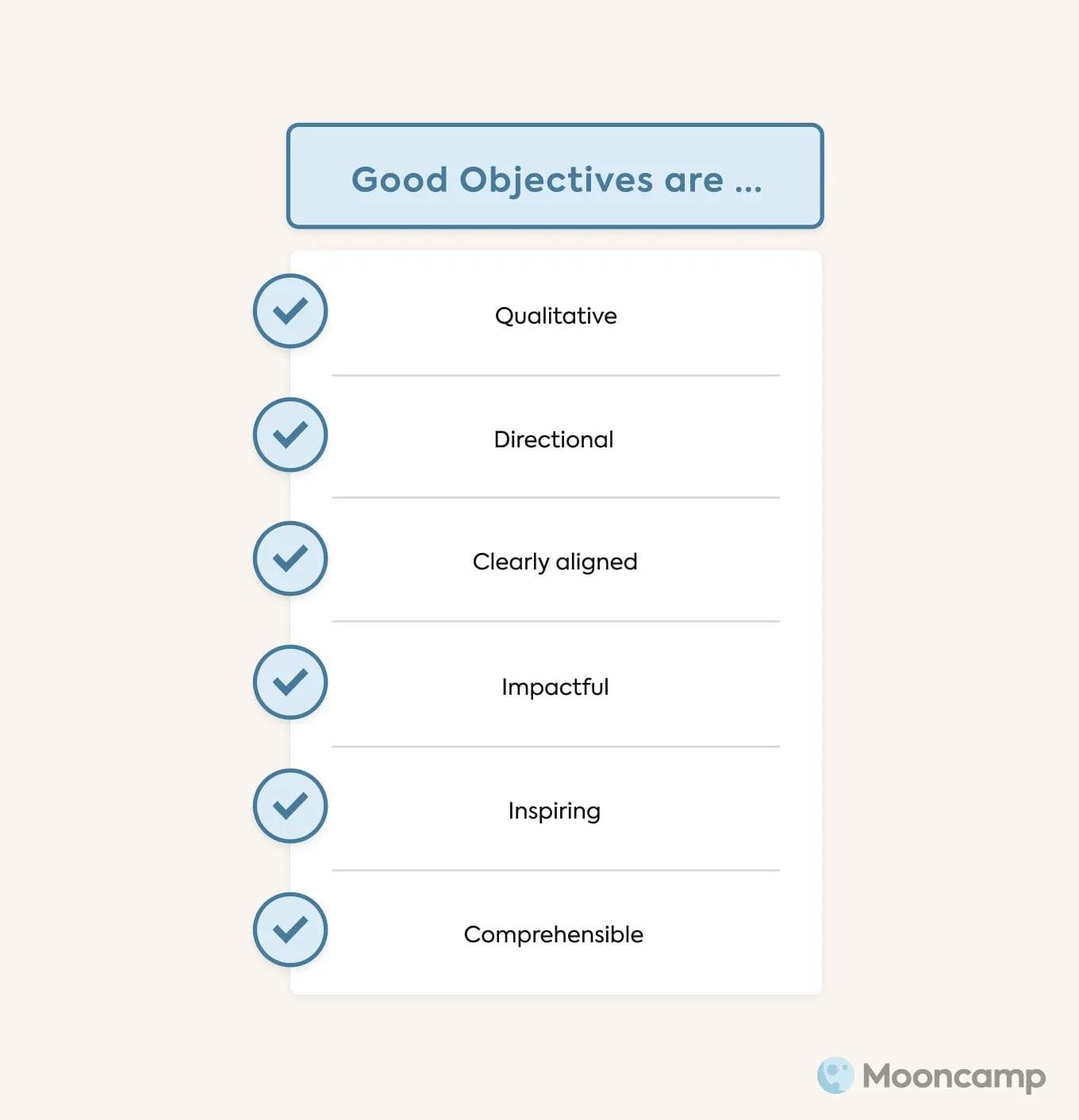
The formula for good Objectives
Finding a wording that meets all of the above criteria can be difficult. There are some basic linguistic rules that should be followed for clear OKRs:
- Use active rather than passive wording
- Use as few foreign words or abbreviations as possible
- Use short and precise wording (rule of thumb: as short as possible, but as much as necessary)
- Avoid negatives and words such as “not" or “none”
- Use positive adjectives and verbs
- Avoid words like “must” or “should”
The following formula sums up what Objectives should express:
[Verb] + [adjective phrase] + [noun] + [adverb phrase]
For example: Significantly increase inbound sales leads for our software.
A well formulated Objective always describes the state of something in the future (what is to be achieved) and is thus visionary.
Verbs that usually work well in this regard because they express that a certain state is to be achieved include:
- Build: create, develop, guarantee, construct, build, found, establish
- Improve: improve, increase, expand, advance, increase, optimize, expand
- Innovate: develop, design, renew, conceive, invent, revise, adapt
Examples of good Objectives
Objectives that are written according to this formula are, for example:
- Create a great workplace
- Build a diverse, high-performing team
- Grow our social media channels into a community
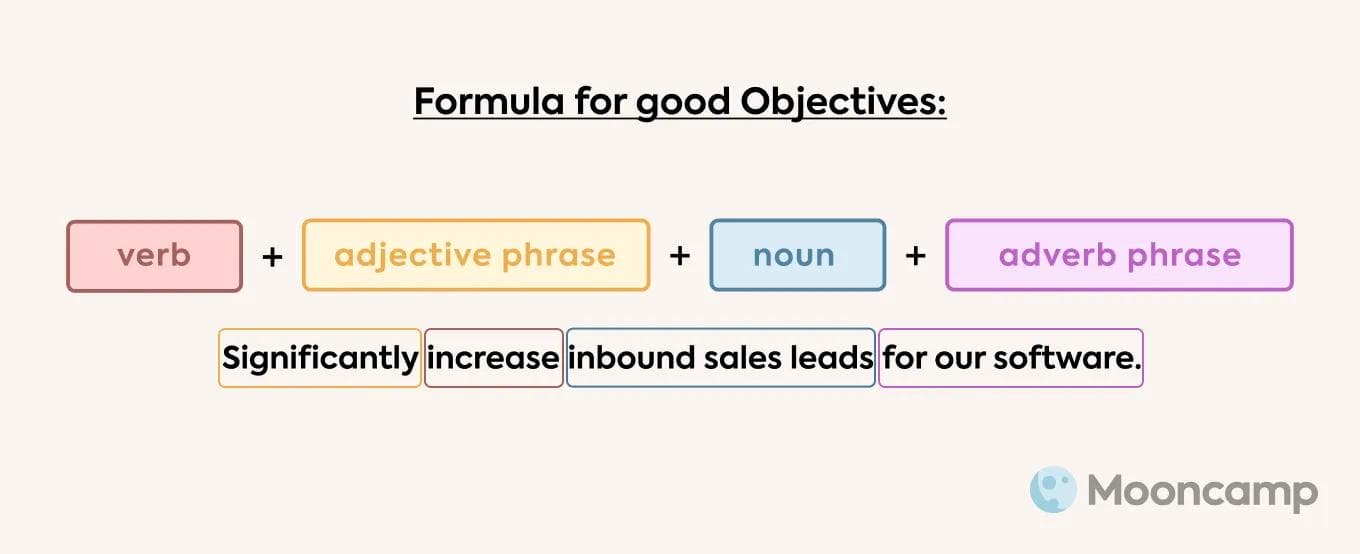
Writing good Key Results
It would not be effective to define Objectives without determining how to measure progress and tell if they have actually been achieved. Therefore, measurable Key Results are necessary as a second building block. In the OKR process, these are derived from the previously defined Objectives.
Checklist for creating Key Results
How do you write Key Results? They should always be comprehensible and formulated as concisely as possible. In addition, there are further, specific criteria that should be fulfilled (must-haves):
- Direct reference to the Objective: A Key Result must always have a direct reference to the Objective, and ideally completely match with the state that is targeted in the Objective. In other words: If all Key Results are achieved, the Objective is also fulfilled.
- Measurable: Key Results must be measurable and therefore always include only one metric.
- Outcome-based: Key Results are not to-do lists with specific activities that can be checked off (these are mapped into initiatives in the OKR framework), but outcomes that can be influenced (more on this in the article on “Output vs. Outcome”).
It also doesn't hurt if a Key Result has the following additional qualities (nice-to-haves):
- Ambitious: Key Results that don't make you feel at least a little uncomfortable are not ambitious enough. Nevertheless, they should also not be set so high that they discourage from the beginning. Otherwise, the rule of thumb is to estimate 30 to 40 percent more than you think is possible. Then the Objective should be at least 70 percent achievable.
- Independent: Key Results ideally include independent metrics that each indicate different progress toward the Objective so that it is ensured that the success of an Objective is examined from all angles.

The formula for good Key Results
Good Key Results always include a metric with a target value. Ideally, a baseline value is also included (if this is not clear from the context).
A good Key Result can be composed according to the following formula:
[Increase/decrease] [MEASURE] from X to Y by [WHEN]
For example: Increase inbound traffic to trial-signup conversion rate from 5 to 20% by March
📝 Note: The time period (e.g. by March) is optional. The end of the respective OKR cycle is implicitly assumed.
In addition, to create Key Results the right way, the following questions can help identify the most meaningful Key Results:
- What customer behavior is influencing our business results?
- What change in customer behavior brings us closer to our Objective? How can we measure this?
- What change in our own behavior brings us closer to our Objective? How can we measure that?
- What would success look and feel like? How can we measure success?
- What weakness might keep us from achieving the Objective?
If you are still not sure which metrics are useful, you can get inspiration from the examples in this article or click through our OKR examples.
💡 Tip: We have collected over 40 OKR examples from real companies for Sales, Marketing, Human Resources & Co.
Examples of good Key Results
Effective Key Results written using this formula (with each target referring to the end of the OKR cycle) include:
- Reduce voluntary departures to 5%
- Increase social media traffic by 40% compared to the previous quarter
- Generate 10% more leads compared to the previous year
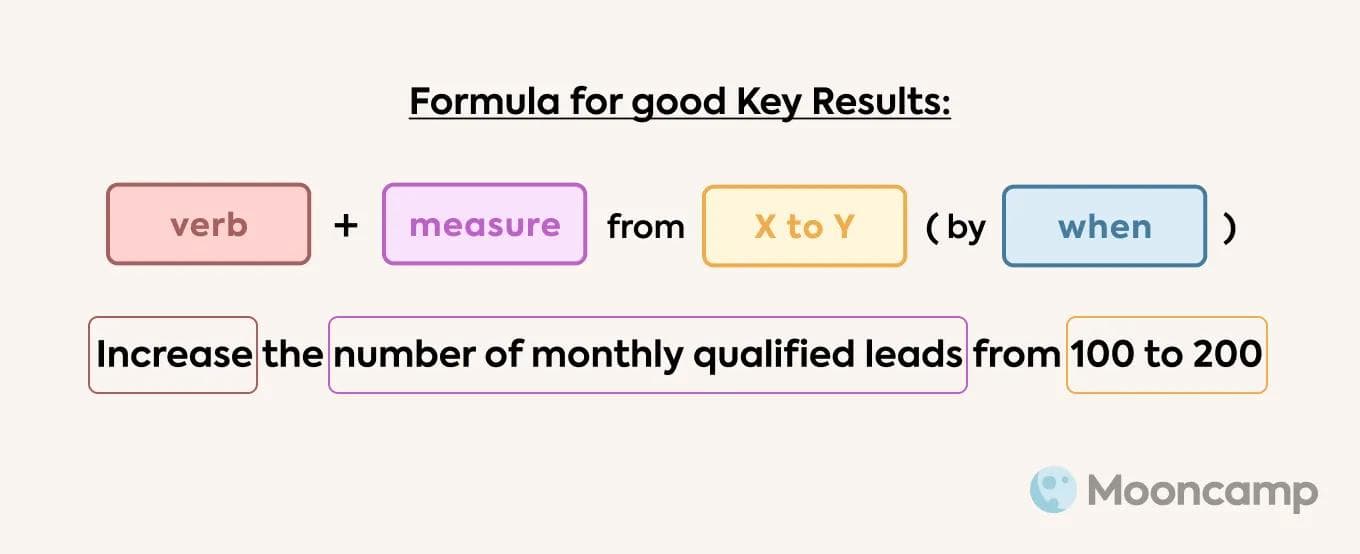
Top 3 common mistakes to avoid when writing OKRs + examples
To ensure that nothing can go wrong, we have compiled the three most common mistakes that companies make when creating OKRs – including examples of less successful formulations:
- ❌ Too general: Objectives should not simply be a nice headline for Key Results. Very broad goals such as “Increase new customer acquisition” or “Improve customer satisfaction” are neither concretely related to the next cycle nor inspiring and motivating enough as Objectives.
- ❌ Too many goals: Many OKR beginners pack multiple Objectives into one sentence. The word “and” is usually an indicator that there are too many goals in one Objective and that the Key Results derived from them can no longer be clearly assigned.
- ❌ Not specific enough: Key Results should always be as specific as possible so that success can be measured correctly. Therefore, they always include a metric. Non-specific Key Results such as “Our Employee Net Promoter Score (eNPS) is higher than in the previous year” are not accurate enough. In this case, it would be better to say, for example, “We achieve an eNPS of 50”.
Writing good initiatives
Initiatives are all the projects, tasks and activities you undertake to reach your Key Results. They can be seen as a to-do list.
Checklist for effective initiatives
Good initiatives should always
- be specific
- be achievable
- be directly influenceable
- have an owner
- be short and to the point, if possible
Formula to write good initiatives
A good initiative can be composed according to the following formula:
[Verb] + [adjective phrase] OR [noun]
For example: Develop a quarterly content calendar
Examples of good initiatives
Initiatives written according to this formula include:
- Launch offline marketing campaign for billboards near cab stands
- Create a regular report on the condition and performance of the website and app
- Create a banner for the foyer
Conclusion: Crafting perfectly formulated OKRs for success
In summary, well-written OKRs always consist of
- 2 to 4 inspiring, qualitative, and directional Objectives per team that answer the question of what is to be achieved (bigger picture), and
- 2 to 2 measurable, specific, and time-bound Key Results per Objective that express how to know that the Objective has been achieved.
Below are two examples, one from project management and one for a marketing team, of how this can look in practice. They come from real companies and can serve as inspiration for your own OKRs.
How to write OKRs – FAQ
What are good OKR examples?
Good OKRs are formulated in an understandable and transparent way. Objectives are effective, directional and qualitative, while Key Results are measurable, specific and time-bound.
An example for a good Objective would be: Maximize our recruiting engine efficiency.
Good Key Results for this Objective would be, among others: (1) Increase Offer Acceptance Rate to 90%, (2) decrease Time to Offer Accept to 45 days, and (3) increase hires vs. planned hires ratio to 0.9.
How do you write OKRs correctly?
Objectives should be active rather than passive and should be as short as possible but as long as necessary. Positive adjectives and verbs should be used in them, negatives and words like “not” or “none” should be avoided. The same applies to words like “must” or “should”. Key results should also be expressed in a clear and understandable way. They should always include a metric, a direction (increase/decrease) and a timeframe.
How are OKRs structured?
OKRs consist of a maximum of 2 to 4 qualitative Objectives per team, each of which is assigned 2 to 4 measurable Key Results. The concrete to-dos that are necessary to achieve the Key Results are mapped in initiatives.
What if I can’t align my Objective to anything?
The fact that an Objective cannot be clearly aligned does not necessarily mean that it is bad. It rather means that it does not fit into the scope set by the corporate strategy.
If this occurs, it should be discussed: Why did you choose the Objective? Why do Objective and company vision differ from each other? Does it still make sense to pursue the Objective? Employees and executives should find a solution together.

